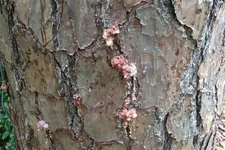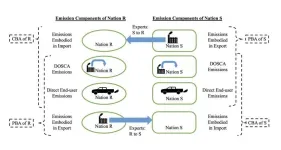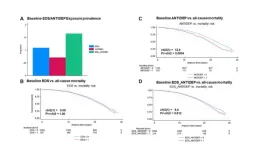(Press-News.org) PHILADELPHIA (June 10, 2024) – Researchers and patient advocates from the Monell Chemical Senses Center, Smell and Taste Association of North America (STANA), and Thomas Jefferson University came together during the COVID-19 pandemic to incorporate patient voices in efforts to prioritize research areas focused on improving care for people with smell and taste disorders.
To this end, in 2022 these collaborators conducted a survey and listening sessions with patients, caregivers, and family members affected by impaired smell or taste. They asked about their individual perceptions of the effectiveness of treatments, among other topics. Using an online questionnaire, over 5,800 people in the U.S. – from all 50 states and the District of Columbia – answered the team’s call to action. The survey results and critical areas for related research are published in Chemical Senses.
Overall their findings underscore the importance of conducting more large-scale, randomized clinical trials that include older participants. They also identified a need to parse results among anosmia, hyposmia, and parosmia to better understand the mechanisms underlying each diagnosis.
“Patient voices sound the urgency for fundamental research on what underlies sensory disorders and how that can be translated into new and better treatments,” said senior author Nancy E. Rawson, PhD, Monell Executive Vice President & Chief Impact Officer.
The team, which also includes researchers from San Diego State University, analyzed the characteristics that predicted whether treatment for smell or taste disorders was reported as effective (or not) for patients aged 18-24, 25-39, 40-60 and 60+ years. No treatments were highly effective. Collectively, the survey participants reported being treated with nasal steroids, oral steroids, zinc, nasal rinse, smell training, theophylline, platelet rich plasma, and Omega 3. The most consistent predictor of low effectiveness was age. The majority of those 40-60 and 60+ years old reported that nasal steroids, oral steroids, zinc, nasal rinse, and smell training were only slightly effective or not effective at all. However, many of these treatment strategies target cell regeneration and immune response, functions that can diminish with age. Only those under the age of 40 reported more-than-slight efficacy of steroids or smell training.
“The pandemic and emergence of long COVID uncovered our lack of knowledge of disorders of smell and taste,” said first author Claire Murphy, PhD, Professor of Psychology at San Diego State University and Adjunct Professor of Psychiatry at the University of California, San Diego. “The overwhelming response of nearly 6,000 people with smell loss and their family members is indicative of how many people are craving for more information and to be heard.”
Patient Feedback Makes a Difference
The survey’s age-related data has important implications for clinical trials that measure treatment effectiveness, emphasizing the need to include patients of all ages. In addition, other studies have shown that older adults with olfactory impairment have an increased risk for Alzheimer’s disease (AD) and other neurodegenerative disorders. The authors of this Chemical Senses article surmise that olfactory impairment associated with long COVID could lead to a significant rise in AD incidence, making clinical research on new treatments for smell loss a key priority.
The efficacy of nasal steroids and smell training was also influenced by the type of diagnosis patients received: People with complete loss of smell (anosmia) rated the training less effective than those with a partial loss (hyposmia), and those with a distorted sense of smell (parosmia) rated nasal steroids less effective than those with hyposmia. Interestingly, people who were unsure of their diagnosis rated smell training as being less effective than those who were diagnosed with a partial loss of smell.
The authors report that in small-group listening sessions, patients from different survey sub-groups, such as those with complete or partial smell loss, shared individual stories on topics that impacted their day-to-day lives. They expressed:
A need to know the cause of their disorders and evidence that a particular treatment is effective.
An interest in smell testing with their primary care physician.
An enthusiasm for participating in clinical trials.
Frustration with treatment strategies that produce little if any benefit and suggesting that new treatments should be tried.
“From the patient survey and listening sessions, we learned that patients have an important and unique perspective based on their own lived experiences that researchers and clinicians should consider,” said co-author Katie Boateng, STANA President. “In particular, patients want to be involved in identifying treatments that directly address impacts on their quality of life.”
Spurred by a Pandemic
This concerted study of patient-centered approaches to combat smell and taste disorders started with a 2020 white paper that summarized research needs for chemosensory disorders. These details were identified at a 2018 meeting held at the Monell Center with clinicians, researchers, and patients. Fast forward two years: COVID dramatically changed the awareness of the loss of smell and taste, a principal, early symptom of infection.
Looking forward, the team suggests a number of priorities for future research:
Developing partnerships among patients, clinicians, and basic scientists to align priorities for research, education, and health care standards.
Increasing accessibility and use of standardized testing methods for diagnosing smell and taste disorders.
Clinical studies of emerging therapeutics need to consider a wide range of ages to address changing capacity for regeneration.
Health care professionals in a wide range of disciplines – from dentistry to nutrition to otolaryngology – need to be provided with training in management of patients with taste and smell disorders.
“These patient voices contributed much to our understanding of olfactory disorders – and their symptoms, diagnoses, treatments, and quality-of-life issues,” said co-author Gurston G. Nyquist, MD, Professor of Otolaryngology and Neurological Surgery at Jefferson. “We need to find ways to partner with patients as we plan future research.”
Editor’s note
Along with Rawson, Boateng, Nyquist, and Murphy, co-authors are Conner Frank and Abigail Albertazzi, San Diego State University; Paule V. Joseph, National Institute of Alcohol Abuse and Alcoholism and National Institute of Nursing; Bita Naimi and Emily Garvey, Thomas Jefferson University; Suz Schrandt, ExPPect, LLC, Arlington, VA; Pamela Silberman, the Smell and Taste Association of North America; and Pamela Dalton, Stephanie Hunter, and Jenifer Trachtman, Monell Center.
This work was supported by the PCORI Engagement Contract (EASC #00261) and the National Institute on Aging (R01AG062006-05). PCORI is an independent, nonprofit organization authorized by Congress to fund research that will provide patients, their caregivers, and clinicians with the evidence-based information needed to make better-informed healthcare decisions.
Other funds provided by the Division of Intramural Research, the National Institute on Alcohol Abuse and Alcoholism (Z01AA000135), the National Institute of Nursing Research and the Office of Workforce Diversity, the National Institutes of Health Distinguished Scholar award, and a Rockefeller University Heilbrunn Nurse Scholar Award.
In the summer of 2023, the Monell Chemical Senses Center, Smell and Taste Association of North America, and Thomas Jefferson University finalized an agreement to collaborate in order to improve the lives of people with smell and taste loss and distortion. This agreement formally connects the three partners with a shared vision that can be used as a template by others to facilitate patient-centered outcomes research across the U.S. The 2022 patient engagement survey and the 2024 Chemical Senses article are products of the PCORI Engagement Contract.
###
The Monell Chemical Senses Center is an independent nonprofit research institute in Philadelphia, Pennsylvania. Monell was founded in 1968, and its mission is to improve health and well-being by advancing the scientific understanding of taste, smell, and related senses, where our discoveries lead to improving nutritional health, diagnosing and treating disease, addressing smell and taste loss, and digitizing chemosensory data.
END
Engaging with patients for better treatments and outcomes for smell and taste disorders
Survey reveals immediate useful insights for planning future research
2024-06-11
ELSE PRESS RELEASES FROM THIS DATE:
Study shows first evidence of sex differences in how pain can be produced
2024-06-10
Research suggests that males and females differ in their experience of pain, but up until now, no one knew why. In a recent study published in BRAIN, University of Arizona Health Sciences researchers became the first to identify functional sex differences in nociceptors, the specialized nerve cells that produce pain.
The findings support the implementation of a precision medicine-based approach that considers patient sex as fundamental to the choice of treatment for managing pain.
“Conceptually, this paper is a big advance in our ...
Hubble finds surprises around a star that erupted 40 years ago
2024-06-10
Astronomers have used new data from NASA's Hubble Space Telescope and the retired SOFIA (Stratospheric Observatory for Infrared Astronomy) as well as archival data from other missions to revisit one of the strangest binary star systems in our galaxy – 40 years after it burst onto the scene as a bright and long-lived nova. A nova is a star that suddenly increases its brightness tremendously and then fades away to its former obscurity, usually in a few months or years.
Between April and September 1975, the binary system HM Sagittae (HM Sge) grew 250 times brighter. Even more unusual, it did not rapidly fade away as novae commonly do, but has ...
NASA’s Webb opens new window on supernova science
2024-06-10
Peering deeply into the cosmos, NASA’s James Webb Space Telescope is giving scientists their first detailed glimpse of supernovae from a time when our universe was just a small fraction of its current age. A team using Webb data has identified 10 times more supernovae in the early universe than were previously known. A few of the newfound exploding stars are the most distant examples of their type, including those used to measure the universe's expansion rate.
"Webb is a supernova ...
May research news from the Ecological Society of America
2024-06-10
The Ecological Society of America (ESA) presents a roundup of four research articles recently published across its six esteemed journals. Widely recognized for fostering innovation and advancing ecological knowledge, ESA’s journals consistently feature illuminating and impactful studies. This compilation of papers explores how wolf reintroduction affects other carnivores, how drought and grazing snails together drive salt marsh productivity, the key to an invasive fish’s success and the plight of backyard trees, ...
Taking the fall: How stunt performers struggle with reporting head trauma
2024-06-10
In the heart-pounding action scenes of your favorite blockbuster, it's not always the A-list actor taking the risks but the unsung heroes—stunt performers—who bring those breathtaking moments to life. However, behind the glamour lies a grim reality: the reluctance of these daredevils to report head trauma, fearing it could jeopardize their careers.
In the recently released blockbuster, “The Fall Guy,” audiences get a behind-the-scenes look at what stunt professionals go through to create those most thrilling moments, and although this film celebrates these skilled professionals, it does not highlight the impact the stunts can have on their health.
Ohio ...
Income inequality and carbon dioxide emissions have a complex relationship
2024-06-10
Income inequality and carbon dioxide emissions for high-income nations such as the United States, Denmark and Canada are intrinsically linked – but a new study from Drexel University has taken a deeper look at the connection and found this relationship is less fixed, can change over time, and differ across emission components. The findings could help countries set a course toward reducing emissions of the harmful greenhouse gas and alleviating domestic income inequality at the same time.
The ...
Yuan elevated to IEEE senior member
2024-06-10
Jinghui Yuan, an R&D staff member in the Applied Research for Mobility Systems group at the Department of Energy’s Oak Ridge National Laboratory, has been elevated to a senior member of the Institute of Electrical and Electronics Engineers, or IEEE.
Senior member status is the highest grade of IEEE and requires extensive experience that reflects professional accomplishments. Only 10% of IEEE’s more than 450,000 members achieve this level.
As a transportation engineer in the Buildings and Transportation Science Division, Yuan’s research focuses on intelligent transportation systems, crash risk prediction, big data analytics, deep learning, traffic simulation and ...
Passive heat exposure increases stress on the heart, posing risk to adults with history of CAD
2024-06-10
Embargoed for release until 5:00 p.m. ET on Monday 10 June 2024
Annals of Internal Medicine Tip Sheet
@Annalsofim
Below please find summaries of new articles that will be published in the next issue of Annals of Internal Medicine. The summaries are not intended to substitute for the full articles as a source of information. This information is under strict embargo and by taking it into possession, media representatives are committing to the terms of the embargo not only on their own behalf, but also on behalf of the organization they represent.
----------------------------
1. ...
Feeling rough after your COVID shot? Congrats, it’s working!
2024-06-10
Feeling Rough After Your COVID Shot? Congrats, It’s Working!
Headache, chills, tiredness may be evidence of a supercharged defense, according to UCSF-led study.
Fewer than 1 in 4 people in the United States have received last year’s updated COVID-19 vaccine, despite a death toll of more than 23,000 Americans this year.
One of the most common reasons for bypassing the COVID vaccine is concern about side effects like tiredness, muscle and joint pain, chills, headache, fever, nausea and feeling generally unwell. But a new study, led by UC San Francisco, has found that the symptoms indicate a robust immune response that is likely to ...
Depression, antidepressants, epigenetic age acceleration, and mortality in postmenopausal women
2024-06-10
“The study examined the impact of depressive symptoms, antidepressant use, and epigenetic age acceleration on all-cause mortality in postmenopausal women.”
BUFFALO, NY- June 10, 2024 – A new research paper was published in Aging (listed by MEDLINE/PubMed as "Aging (Albany NY)" and "Aging-US" by Web of Science) Volume 16, Issue 10, entitled, “Relationships of depression and antidepressant use with epigenetic age acceleration and all-cause mortality among postmenopausal women.”
In this new study, researchers May A. Beydoun, Hind A. Beydoun, Jason Ashe, Michael F. Georgescu, Steve Horvath, Ake Lu, Anthony S. Zannas, ...
LAST 30 PRESS RELEASES:
Injectable breast ‘implant’ offers alternative to traditional surgeries
Neuroscientists devise formulas to measure multilingualism
New prostate cancer trial seeks to reduce toxicity without sacrificing efficacy
Geometry shapes life
A CRISPR screen reveals many previously unrecognized genes required for brain development and a new neurodevelopmental disorder
Hot flush treatment has anti-breast cancer activity, study finds
Securing AI systems against growing cybersecurity threats
Longest observation of an active solar region
Why nail-biting, procrastination and other self-sabotaging behaviors are rooted in survival instincts
Regional variations in mechanical properties of porcine leptomeninges
Artificial empathy in therapy and healthcare: advancements in interpersonal interaction technologies
Why some brains switch gears more efficiently than others
UVA’s Jundong Li wins ICDM’S 2025 Tao Li Award for data mining, machine learning
UVA’s low-power, high-performance computer power player Mircea Stan earns National Academy of Inventors fellowship
Not playing by the rules: USU researcher explores filamentous algae dynamics in rivers
Do our body clocks influence our risk of dementia?
Anthropologists offer new evidence of bipedalism in long-debated fossil discovery
Safer receipt paper from wood
Dosage-sensitive genes suggest no whole-genome duplications in ancestral angiosperm
First ancient human herpesvirus genomes document their deep history with humans
Why Some Bacteria Survive Antibiotics and How to Stop Them - New study reveals that bacteria can survive antibiotic treatment through two fundamentally different “shutdown modes”
UCLA study links scar healing to dangerous placenta condition
CHANGE-seq-BE finds off-target changes in the genome from base editors
The Journal of Nuclear Medicine Ahead-of-Print Tip Sheet: January 2, 2026
Delayed or absent first dose of measles, mumps, and rubella vaccination
Trends in US preterm birth rates by household income and race and ethnicity
Study identifies potential biomarker linked to progression and brain inflammation in multiple sclerosis
Many mothers in Norway do not show up for postnatal check-ups
Researchers want to find out why quick clay is so unstable
Superradiant spins show teamwork at the quantum scale
[Press-News.org] Engaging with patients for better treatments and outcomes for smell and taste disordersSurvey reveals immediate useful insights for planning future research





